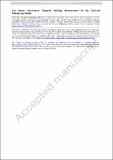| dc.contributor.author | Huber, Zachary B. | |
| dc.contributor.author | Li, Yaqiong | |
| dc.contributor.author | Vavagiakis, Eve M. | |
| dc.contributor.author | Choi, Steve K. | |
| dc.contributor.author | Connors, Jake | |
| dc.contributor.author | Cothard, Nicholas F. | |
| dc.contributor.author | Duell, Cody J. | |
| dc.contributor.author | Galitzki, Nicholas | |
| dc.contributor.author | Healy, Erin | |
| dc.contributor.author | Hubmayr, Johannes | |
| dc.contributor.author | Johnson, Bradley R. | |
| dc.contributor.author | Keller, Ben | |
| dc.contributor.author | McCarrick, Heather | |
| dc.contributor.author | Niemack, Michael D. | |
| dc.contributor.author | Wang, Yuhan | |
| dc.contributor.author | Xu, Zhilei | |
| dc.date.accessioned | 2022-11-28T14:22:01Z | |
| dc.date.available | 2022-11-28T14:22:01Z | |
| dc.date.issued | 2022-09-26 | |
| dc.identifier.uri | https://hdl.handle.net/1721.1/146614 | |
| dc.description.abstract | Abstract
The Simons Observatory (SO) includes four telescopes that will measure the temperature and polarization of the cosmic microwave background using over 60,000 highly sensitive transition-edge bolometers (TES). These multichroic TES bolometers are read out by a microwave RF SQUID multiplexing system with a multiplexing factor of 910. Given that both TESes and SQUIDs are susceptible to magnetic field pickup and that it is hard to predict how they will respond to such fields, it is important to characterize the magnetic response of these systems empirically. This information can then be used to limit spurious signals by informing magnetic shielding designs for the detectors and readout. This paper focuses on measurements of magnetic pickup with different magnetic shielding configurations for the SO universal multiplexing module (UMM), which contains the SQUIDs, associated resonators, and TES bias circuit. The magnetic pickup of a prototype UMM was tested under three shielding configurations: no shielding (copper packaging), aluminum packaging for the UMM, and a tin/lead-plated shield surrounding the entire dilution refrigerator 100 mK cold stage. We also present measurements of the pickup in the UMM when aluminum feedhorns are installed. The measurements show that the aluminum packaging outperforms the copper packaging by a shielding factor of 8-10, and adding the tin/lead-plated 1K shield further increases the relative shielding factor in the aluminum configuration by 1-2 orders of magnitude. The addition of feedhorns provides a factor of 30 improvement when the tin/lead shield is not installed and a factor of 5 improvement when it is. | en_US |
| dc.publisher | Springer US | en_US |
| dc.relation.isversionof | https://doi.org/10.1007/s10909-022-02875-w | en_US |
| dc.rights | Article is made available in accordance with the publisher's policy and may be subject to US copyright law. Please refer to the publisher's site for terms of use. | en_US |
| dc.source | Springer US | en_US |
| dc.title | The Simons Observatory: Magnetic Shielding Measurements for the Universal Multiplexing Module | en_US |
| dc.type | Article | en_US |
| dc.identifier.citation | Huber, Zachary B., Li, Yaqiong, Vavagiakis, Eve M., Choi, Steve K., Connors, Jake et al. 2022. "The Simons Observatory: Magnetic Shielding Measurements for the Universal Multiplexing Module." | |
| dc.contributor.department | MIT Kavli Institute for Astrophysics and Space Research | |
| dc.eprint.version | Author's final manuscript | en_US |
| dc.type.uri | http://purl.org/eprint/type/JournalArticle | en_US |
| eprint.status | http://purl.org/eprint/status/PeerReviewed | en_US |
| dc.date.updated | 2022-11-24T04:44:19Z | |
| dc.language.rfc3066 | en | |
| dc.rights.holder | The Author(s), under exclusive licence to Springer Science+Business Media, LLC, part of Springer Nature | |
| dspace.embargo.terms | Y | |
| dspace.date.submission | 2022-11-24T04:44:19Z | |
| mit.license | PUBLISHER_POLICY | |
| mit.metadata.status | Authority Work and Publication Information Needed | en_US |
